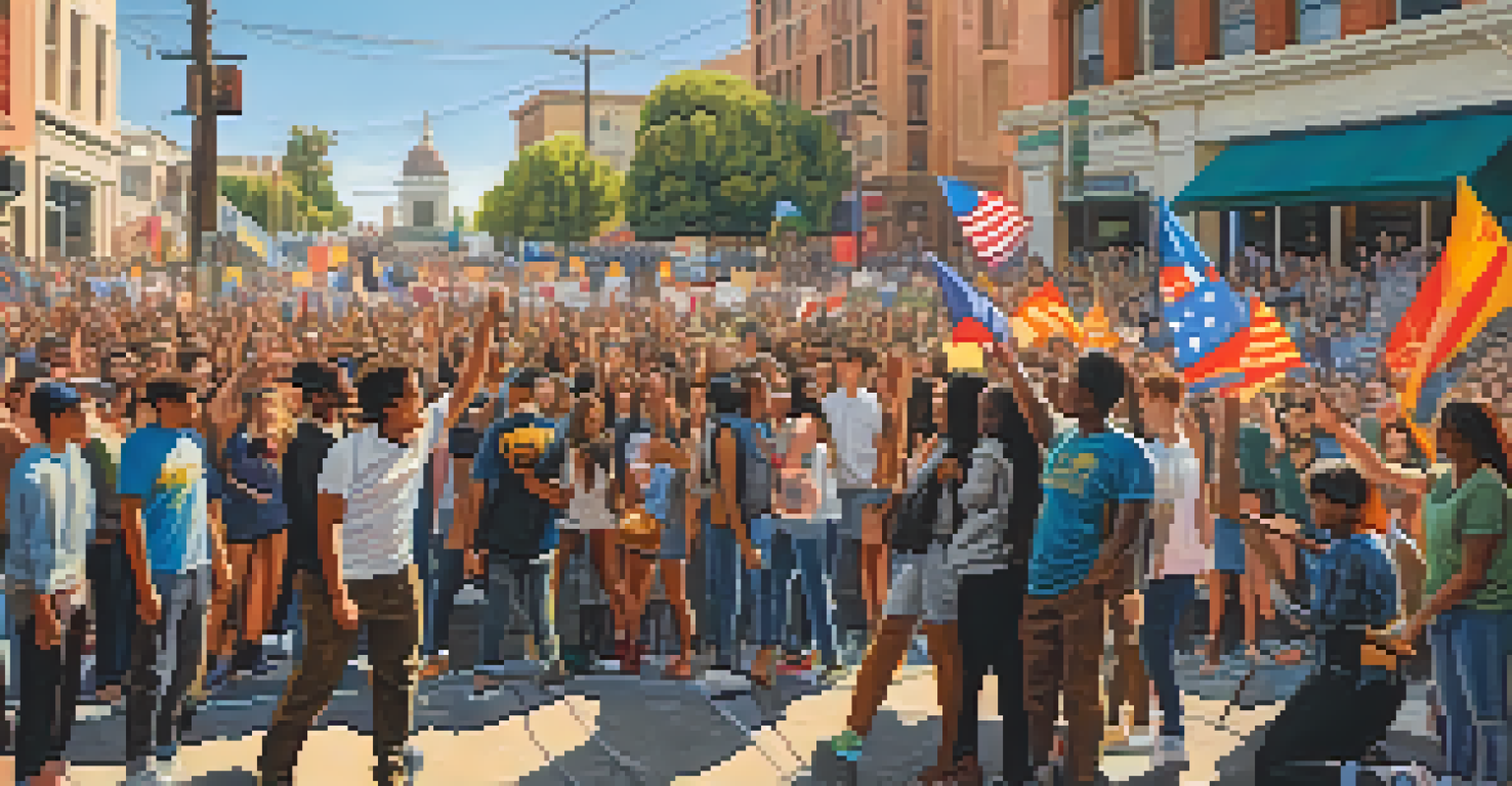Social Media's Role in Shaping California Teen Activism

The Rise of Social Media as an Activism Tool
In today's digital age, social media platforms like Instagram, TikTok, and Twitter have become essential tools for activism, especially among California's teens. These platforms allow young activists to share their messages quickly and effectively, reaching large audiences with just a few clicks. For many, social media is not just an outlet for expression; it’s a way to mobilize friends and peers around issues they care about, from climate change to racial justice.
The power of social media is that it forces necessary change, often faster than traditional means of activism ever could.
Unlike traditional forms of activism, social media enables instant communication and collaboration. For instance, a teenager can post a call to action for a local protest and have dozens of supporters respond within minutes. This immediacy fosters a sense of community and urgency that can be incredibly motivating, transforming individual concerns into collective action almost overnight.
Moreover, social media offers a level of accessibility that traditional activism often lacks. Teenagers can engage with movements from the comfort of their homes, learning about different causes and finding their voices without the barriers that may exist in physical spaces. This democratization of activism empowers a generation that is not only tech-savvy but also socially conscious.
Case Studies: Successful Teen-Led Movements
California has witnessed several successful teen-led movements that owe much of their momentum to social media. One notable example is the March for Our Lives movement, which was largely organized through platforms like Twitter and Instagram. Teen survivors of gun violence used these platforms to share their stories, rallying support and organizing a nationwide march that brought attention to gun control issues.

Another significant movement is the youth-led climate activism spearheaded by groups like Sunrise Movement. California teens have utilized social media to spread awareness about climate change, organize strikes, and engage with political leaders in a way that feels immediate and impactful. Their ability to go viral with their messages has drawn in thousands of supporters, amplifying their calls for action.
Social Media Empowers Young Activists
Platforms like Instagram and Twitter enable California teens to mobilize quickly around social issues, turning individual concerns into collective action.
These case studies illustrate how social media can serve as a catalyst for change, showcasing the power of youth voices when they unite for a common cause. By sharing personal stories and rallying their peers, California teens have effectively turned their frustrations into movements that challenge the status quo.
The Power of Hashtags in Mobilizing Support
Hashtags have revolutionized how movements gain traction on social media. For California teens, hashtags like #BlackLivesMatter and #FridaysForFuture not only organize information but also connect individuals across the state and beyond. This simple yet powerful tool allows users to follow conversations, share resources, and participate in larger dialogues surrounding social justice and environmental issues.
Activism is not about what you can do alone; it’s about what you can do together, amplifying each other's voices.
When teens use a specific hashtag, they effectively join a global conversation, making their voices part of a broader narrative. For instance, the #MeToo movement gained unprecedented attention through social media, with countless teens sharing their stories of harassment and assault. This collective sharing fosters solidarity and encourages others to speak out, creating a ripple effect that can lead to real change.
Furthermore, hashtags can help sustain momentum for ongoing campaigns. By continuously engaging with specific tags, teen activists can remind their peers of the importance of their causes, ensuring these issues remain front and center in public discourse. This keeps the conversation alive and encourages ongoing participation, pushing for legislative and social changes.
Connecting with Influencers and Celebrities
In an era where influencer culture dominates social media, California teens have learned to leverage the reach of celebrities to amplify their causes. Many young activists tag influencers in their posts, hoping to catch the attention of those with large followings. When an influencer shares a teen's message, it can lead to increased visibility and support for an issue, demonstrating the interconnectedness of social media and activism.
For example, when popular figures like Billie Eilish or Emma Watson advocate for climate action, they indirectly motivate their younger fans to take part in activism as well. This creates a cascading effect, where the support of one influential person can inspire thousands of teens to engage with critical issues. Consequently, the synergy between teen activists and celebrities can significantly enhance the impact of their campaigns.
Hashtags Amplify Activism
Hashtags like #BlackLivesMatter connect teens across California, fostering solidarity and sustaining momentum for social justice movements.
Moreover, this connection between teens and influencers can also lead to mentorship opportunities. Young activists often seek guidance from established figures, learning how to navigate the complexities of advocacy. This relationship not only empowers the teens but also enriches the broader activist community, as experienced voices help shape the next generation of leaders.
The Role of Online Communities in Teen Activism
Online communities have become vital spaces for California teens to connect with like-minded individuals. Platforms like Discord, Reddit, and Facebook groups allow teens to discuss issues, share strategies, and support one another in their activism. These digital safe havens foster a sense of belonging, especially for those who may feel isolated in their offline environments.
For instance, teens passionate about mental health advocacy can find communities where they can share their stories and resources. This sense of solidarity not only provides emotional support but also empowers individuals to become more active in their causes. When teens feel understood and supported, they are more likely to take bold actions, such as organizing events or participating in protests.
Additionally, these online communities can serve as incubators for new ideas and strategies. As teens collaborate and brainstorm within these spaces, they can develop innovative approaches to activism that might not emerge in traditional settings. This dynamic exchange of ideas enhances the overall effectiveness of their efforts, pushing boundaries and expanding the reach of their movements.
Navigating Challenges: Misinformation and Negativity
While social media offers numerous advantages for teen activism, it also presents challenges, particularly in the form of misinformation. In today's fast-paced digital landscape, false information can spread just as quickly as genuine activism. California teens must learn to discern credible sources and combat misinformation to ensure their messages are rooted in facts and truth.
Moreover, the anonymity of social media can lead to negativity and cyberbullying. Activists often face backlash or harassment for their views, which can be disheartening. However, many teens are learning to navigate these challenges by cultivating resilience and supporting one another. By building a strong community, they can foster an environment where positivity prevails over negativity.
Community Support Fuels Engagement
Online communities provide California teens with safe spaces to share ideas and strategies, enhancing their activism and emotional support.
Ultimately, it’s crucial for young activists to develop critical thinking skills and digital literacy. By educating themselves and their peers about how to identify misinformation, they can make informed decisions and strengthen their activism. This not only enhances their own efforts but also encourages a more informed and engaged community.
Looking Ahead: The Future of Teen Activism
As social media continues to evolve, so too will the landscape of teen activism in California. With emerging platforms and technologies, young activists will likely find new ways to connect, organize, and advocate for their causes. The rise of video content, for example, presents exciting opportunities for storytelling and engagement, allowing activists to share their messages in dynamic and impactful ways.
Furthermore, as teens become more adept at using social media for activism, they may also influence the platforms themselves to create spaces that are more supportive of social causes. This could lead to features that prioritize educational content or tools that assist in organizing events, ultimately transforming social media into an even more powerful vehicle for change.

In conclusion, the future of teen activism in California is bright, fueled by creativity, passion, and the power of social media. As young activists continue to harness these tools, they will undoubtedly shape the conversations around critical issues, paving the way for a more equitable and just society.